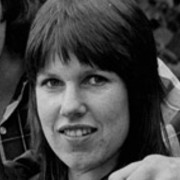
Beaver (Beverley Morrison)
Singer Beaver's career had an auspicious start, when she joined the melting pot of creative talent known as Blerta.
Raised in Wellington's Hutt Valley, Beaver - real name Beverley Morrison - was the daughter of pianist John Morrison.
In the late 60s she began to visit, and occasionally sing, at jazz club The Wellington Musician's' Club, which future Blerta member Geoff Murphy would describe as "not very well patronised, [with a] a dozen people being regarded as a very satisfactory 'crowd'."
According to legend, Blerta founder Bruno Lawrence had Morrison pegged as a singer for the group as soon as he heard her husky voice. Impressed by her singing talents, Lawrence would invite her to play alongside his band Littlejohns. It was around this point that Morrison began to be known professionally as Beaver, a nickname from childhood.
In late 1971 an article appeared in Wellington newspaper Sports Post headlined "LOOK OUT! HERE COMES BLERTA". The article announced the arrival of a "travelling band of musicians, actors, light show operators, movie people and friends on a tour of New Zealand." Keen to sign a woman vocalist for the tour, Bruno gave Beaver the job. So began her first stint in the Bruno Lawrence Electric Revelation Travelling Apparition, better known as Blerta. Gigs ranged from performances in local parks, to packing Wellington's St James Theatre.
Blerta's line-up saw many arrivals and departures. In 1974 the latest incarnation of Blerta (this time without Beaver) recorded the album This is the Life in Sydney, with contributions from Australian singer Renee Geyer. But Geyer was already signed to another record label; the threat of legal action over Geyer singing for a different label meant that Beaver later rerecorded Geyer's lead vocals back in New Zealand.
Beaver also made appearances - both as singer and occasional actor - on the troupe's 1975 New Zealand tour, and in their self-titled television series. She can be seen in Blerta Revisited, a compilation of Blerta material made by director Geoff Murphy (including her performance of Blerta single 'This is the Life' in clip three).
Beaver and Bruno Lawrence would play together in many permutations over the years, including the Beaver Band which she formed in the mid 70s, and at a successful gig at the headquarters of the Head Hunters gang. Beaver later told Bruno biographer Roger Booth that when she sang a line, Lawrence was able to embellish it, "with splatters of colour. He drummed colours."'
Beaver performed on a number of occasions with another influential multi-media troupe, Red Mole, then spent time with Midge Marsden's Country Flyers, whose members included future Once Were Warriors composer Murray McNabb.
In 1978 Beaver sang lead vocals on two tracks for Geoff Steven's feature debut, small town drama Skin Deep. One of them was the title song. She was backed by the Country Flyers; they are credited as Beaver and The Flyers.
An operation to remove nodes from her vocal chords left Beaver unable to sing for more than six months, costing her the chance to be part of soon-to-be-big pop group The Pink Flamingos. But she recovered to resume her career, including famously singing the theme song to TV's Gloss, which was released as a 1988 single (under the name Beaver Storm).
She also put in a solid performance as a singer and mother in 1985 drug thriller Should I Be Good?, a multi-national tale of money-laundering, murder and nightclubs directed by New Zealander Grahame McLean, the film features a number of musicians in its cast - including Hello Sailor's Harry Lyon in the lead role. Hammond Gamble and Beaver duet on the film's title track.
Beaver continued to sing across a range of genres. At the 1988 New Zealand Music Awards she was named jazz performer of the year for album Live at Ronnie Scott's.
Beaver died in May 2010, after a battle with cancer.